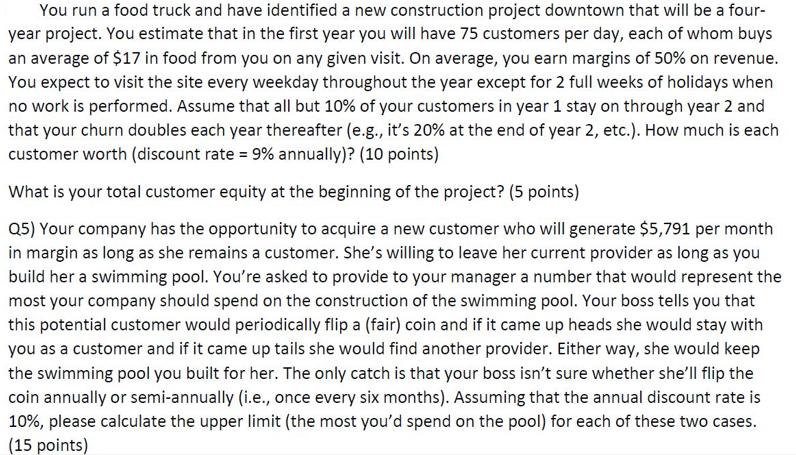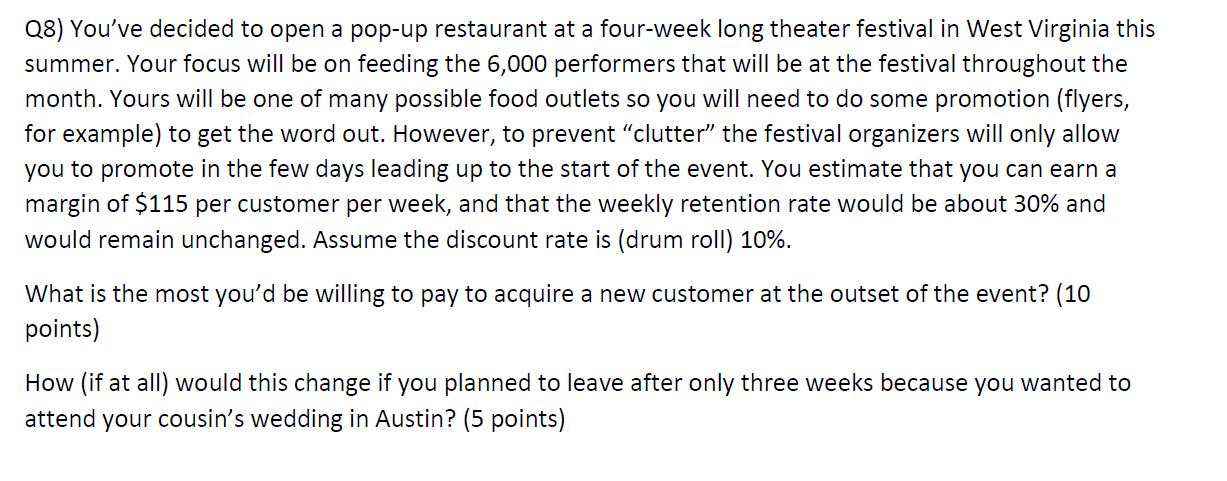Answered step by step
Verified Expert Solution
Question
1 Approved Answer
You run a food truck and have identified a new construction project downtown that will be a four- year project. You estimate that in




You run a food truck and have identified a new construction project downtown that will be a four- year project. You estimate that in the first year you will have 75 customers per day, each of whom buys an average of $17 in food from you on any given visit. On average, you earn margins of 50% on revenue. You expect to visit the site every weekday throughout the year except for 2 full weeks of holidays when no work is performed. Assume that all but 10% of your customers in year 1 stay on through year 2 and that your churn doubles each year thereafter (e.g., it's 20% at the end of year 2, etc.). How much is each customer worth (discount rate = 9% annually)? (10 points) What is your total customer equity at the beginning of the project? (5 points) Q5) Your company has the opportunity to acquire a new customer who will generate $5,791 per month in margin as long as she remains a customer. She's willing to leave her current provider as long as you build her a swimming pool. You're asked to provide to your manager a number that would represent the most your company should spend on the construction of the swimming pool. Your boss tells you that this potential customer would periodically flip a (fair) coin and if it came up heads she would stay with you as a customer and if it came up tails she would find another provider. Either way, she would keep the swimming pool you built for her. The only catch is that your boss isn't sure whether she'll flip the coin annually or semi-annually (i.e., once every six months). Assuming that the annual discount rate is 10%, please calculate the upper limit (the most you'd spend on the pool) for each of these two cases. (15 points) Q6) You get a text from your boss -- your organization's CMO - who is sitting in a meeting with the CEO. Your boss needs your help. She tells you that the data scientist who preceded you had generated a CLV estimate for new customers in the East of $678 and in the West of $549. The annual discount rate was 10% as usual and she recalls that the annual retention rate was assumed to be 90% for both segments. She didn't remember what the margin assumptions were, but she does remember that they were the same across segments. What the CEO wants to know, though, is that even though we all know that there will be no growth in the West, what assumption was made on the growth rate in the East? (10 points) Q7) Imagine you're deciding which of two acquisition channels to invest in. Display Ads will attract customers that on average have annual margins twice that of customers attracted through Search Ads but with lower retention rates. How much lower would the retention rate have to be in order to make you indifferent between the two channels, assuming the discount rate is .10? Specifically, if the Display Ad retention rate is rp and the Search Ad retention rate is rs, what would the ratio S need to be for TD these channels to yield customers with equal CLV's? For this analysis, assume the CAC's are the same. Hint: the answer will be a function of rs. (10 points) What does this result tell us about the relative impact of margin and retention on CLV? (5 points) Q8) You've decided to open a pop-up restaurant at a four-week long theater festival in West Virginia this summer. Your focus will be on feeding the 6,000 performers that will be at the festival throughout the month. Yours will be one of many possible food outlets so you will need to do some promotion (flyers, for example) to get the word out. However, to prevent "clutter" the festival organizers will only allow you to promote in the few days leading up to the start of the event. You estimate that you can earn a margin of $115 per customer per week, and that the weekly retention rate would be about 30% and would remain unchanged. Assume the discount rate is (drum roll) 10%. What is the most you'd be willing to pay to acquire a new customer at the outset of the event? (10 points) How (if at all) would this change if you planned to leave after only three weeks because you wanted to attend your cousin's wedding in Austin? (5 points)
Step by Step Solution
★★★★★
3.41 Rating (157 Votes )
There are 3 Steps involved in it
Step: 1
Customer equity in the food truck example Your customer equity for the fouryear construction project is 1039709 This is calculated using the following steps Calculate the customer lifetime value CLV o...
Get Instant Access to Expert-Tailored Solutions
See step-by-step solutions with expert insights and AI powered tools for academic success
Step: 2

Step: 3

Ace Your Homework with AI
Get the answers you need in no time with our AI-driven, step-by-step assistance
Get Started


